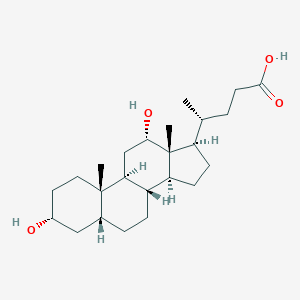Details of the Drug
General Information of Drug (ID: DM3GYAL)
| Drug Name |
Deoxycholic acid
|
||||||||||||||||||||||||||||||
|---|---|---|---|---|---|---|---|---|---|---|---|---|---|---|---|---|---|---|---|---|---|---|---|---|---|---|---|---|---|---|---|
| Synonyms |
(3alpha,5beta,12alpha)-3,12-Dihydroxycholan-24-oic acid; 3,12-Dihydroxycholanic acid; 3alpha,12alpha-Dihydroxy-5beta-cholan-24-oic acid; 3alpha,12alpha-Dihydroxy-5beta-cholanic acid; 5-beta-Deoxycholic acid; 7-Deoxycholic acid; 7alpha-Deoxycholic acid; ATX-101; Choleic acid; Cholerebic; Cholic acid, deoxy-; Cholorebic; DEOXYCHOLIC ACID; Degalol; Deoxy cholic acid; Deoxycholatic acid; Desoxycholic acid; Desoxycholsaeure; Dihydroxycholanoic acid; Droxolan; Pyrochol; Septochol; Sodium deoxycholate; deoxycholate
|
||||||||||||||||||||||||||||||
| Indication |
|
||||||||||||||||||||||||||||||
| Drug Type |
Small molecular drug
|
||||||||||||||||||||||||||||||
| Structure |
 |
||||||||||||||||||||||||||||||
| 3D MOL | 2D MOL | ||||||||||||||||||||||||||||||
| #Ro5 Violations (Lipinski): 0 |
Molecular Weight | 392.58 | |||||||||||||||||||||||||||||
| Logarithm of the Partition Coefficient | Not Available | ||||||||||||||||||||||||||||||
| Rotatable Bond Count | 4 | ||||||||||||||||||||||||||||||
| Hydrogen Bond Donor Count | 3 | ||||||||||||||||||||||||||||||
| Hydrogen Bond Acceptor Count | 4 | ||||||||||||||||||||||||||||||
| ADMET Property | |||||||||||||||||||||||||||||||
| Adverse Drug Reaction (ADR) |
|
||||||||||||||||||||||||||||||
| Chemical Identifiers |
|
||||||||||||||||||||||||||||||
| Cross-matching ID | |||||||||||||||||||||||||||||||
Molecular Interaction Atlas of This Drug
 Drug Transporter (DTP) |
|
|||||||||||||||||||||||||||||||||||||||||||||||||||||||||||||||||||||||
|---|---|---|---|---|---|---|---|---|---|---|---|---|---|---|---|---|---|---|---|---|---|---|---|---|---|---|---|---|---|---|---|---|---|---|---|---|---|---|---|---|---|---|---|---|---|---|---|---|---|---|---|---|---|---|---|---|---|---|---|---|---|---|---|---|---|---|---|---|---|---|---|---|
 Drug Off-Target (DOT) |
|
|||||||||||||||||||||||||||||||||||||||||||||||||||||||||||||||||||||||
| Molecular Interaction Atlas (MIA) | ||||||||||||||||||||||||||||||||||||||||||||||||||||||||||||||||||||||||
References
